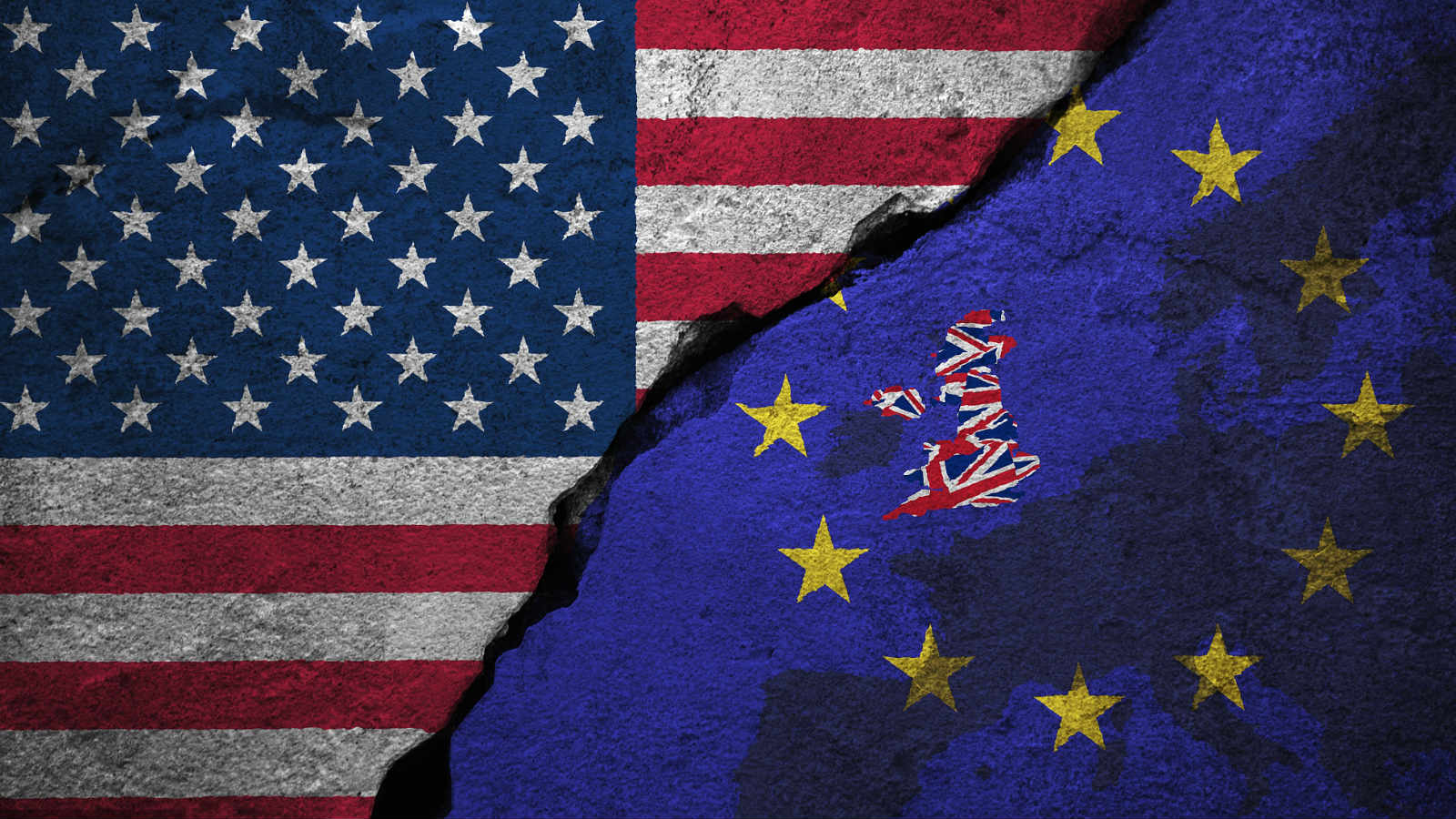Editor's note: With 2018 drawing to a close, it is time to review the many ups and downs that occurred in the international community. Among others, the U.S.-EU relations have been thrown into the spotlight, making the world wonder if the good old alliance is on the brink of breaking. In this article for CGTN, William Jones, the Washington bureau chief for the Executive Intelligence Review, and non-resident senior fellow of Chongyang Institute for Financial Studies at Renmin University of China, shares his insights.
The much-touted Transatlantic Alliance between the United States and Europe has become rather frayed during the recent period, particularly since the election of Donald Trump as U.S. president, which came as an equally big surprise to the European leaders as it was to most U.S. political pundits.
Trade or no trade?
President Trump's decision to pull out of the Paris climate agreement caused the first ruckus with the Europeans. But it was Trump's imposition of tariffs on steel and aluminum imports that really knocked them for a loop. His clear predilection for bilateral rather than multilateral agreements has also caused some perturbation for the Europeans.
When Theresa May seemed to have achieved something of a workable Brexit agreement with the EU, President Trump indicated that the prerogatives which the British would still retain with the EU in the terms of this agreement could prohibit them from negotiating a separate trade agreement with the United States. But, in spite of the threat, it is unlikely that the U.S. will not come to some settlement with Great Britain on trade.
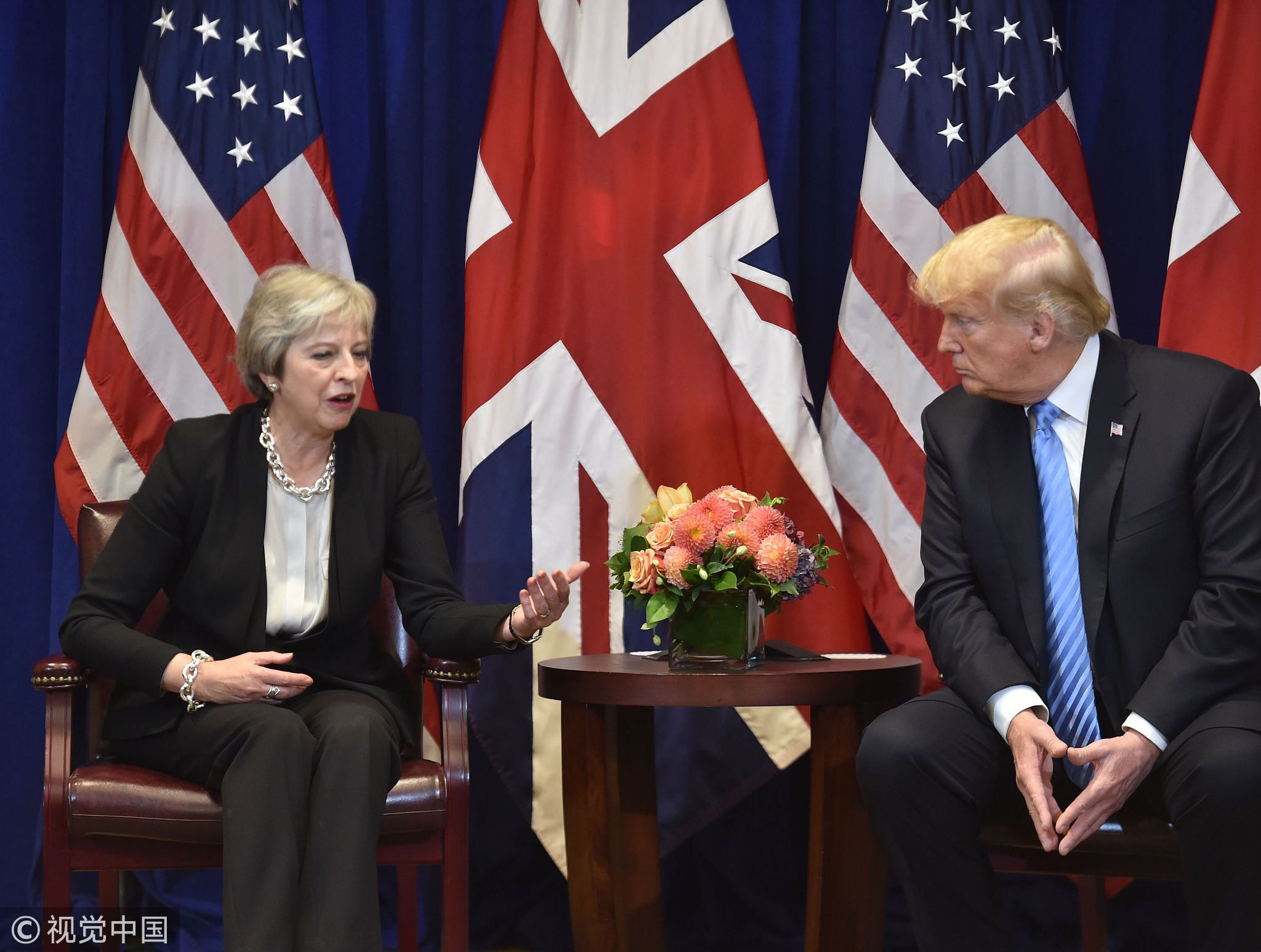
British Prime Minister Theresa May (L) meets with U.S. President Donald Trump on the sidelines of the United Nations General Assembly (UNGA) in New York, September 26, 2018. /VCG Photo
British Prime Minister Theresa May (L) meets with U.S. President Donald Trump on the sidelines of the United Nations General Assembly (UNGA) in New York, September 26, 2018. /VCG Photo
While the "special relationship" between these two English-speaking countries is largely a thing of the past since President Trump came to power, the important trade relationship will not be entirely abandoned given that EU is the largest trading partner with the U.S. and Trump cannot afford two trade war fronts.
On NATO and Russia, the rift is getting deep
The chilliness in the relationship has also spilled over into the strategic relationship between Europe and the United States. President Trump had initially expressed serious skepticism about the importance of NATO and the U.S.-EU military relationship, frustrated that the Europeans were not paying more in their own defense and somewhat frustrated about the endless wars that NATO was involved in.
While under pressure from the Atlanticist crowd in the U.S. and in Europe, he quickly changed his tune on the matter, and made statements underlining the importance of NATO. Nevertheless, it was clear that he was more inclined to work together with Russian leader Vladimir Putin in order to bring down tensions on the continent than to follow those in NATO calling for a more muscular policy toward Russia.
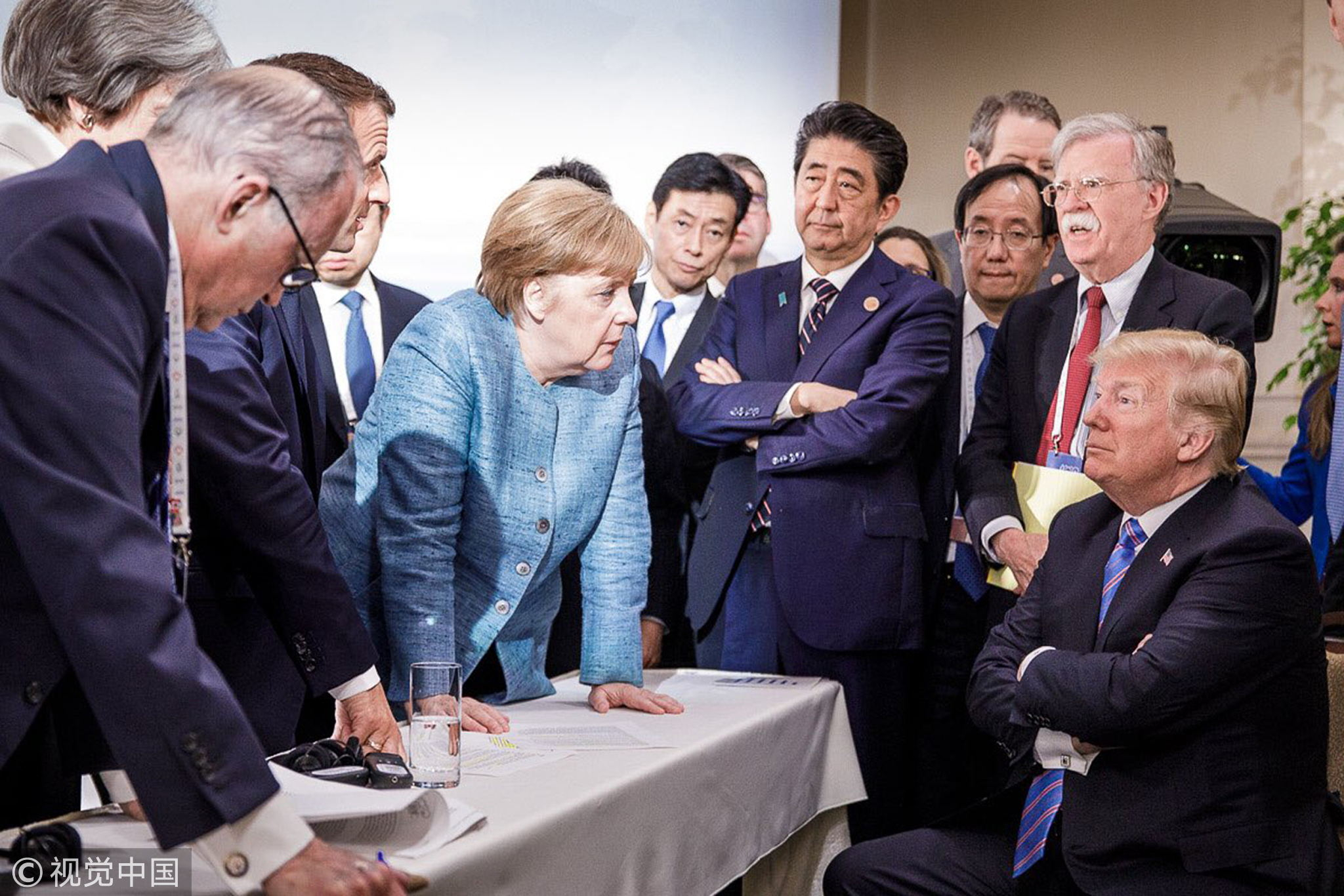
German Chancellor Angela Merkel speaks to U.S. President Donald Trump during sideline discussions on Day 2 of the G7 summit in La Malbaie, Quebec, Canada, June 9, 2018. /VCG Photo
German Chancellor Angela Merkel speaks to U.S. President Donald Trump during sideline discussions on Day 2 of the G7 summit in La Malbaie, Quebec, Canada, June 9, 2018. /VCG Photo
While the German leadership may also have been interested in a less strident policy toward Russia, the Atlanticist leadership in NATO was furious at Trump. Since the beginning of his presidency, there has been a consistent attempt by the Atlanticist crowd to prevent Trump from even talking with Putin, an attempt which has only been partially successful. The Mueller investigation into “Russian interference” in the U.S. election is part and parcel of this campaign.
The uncertainties stemming from Trump's ambiguity toward NATO and even more his desire to establish a working relationship with the Russian leader has also led President Macron to propose that Europe create its own independent military force. But this proposal will probably not get very far given the opposition within most of the other NATO countries to such a move, who fear it would lead to the demise of NATO.
EU in disarray?
While the European governments were taken aback by this radical shift in U.S. politics, they were no doubt even more upset by the shifting winds in Europe as well, stirred up by the same discontent that had affected the U.S. population. That well-oiled machine of the European Union in Brussels, which felt empowered to dictate its members' policies that it deemed “fiscally sound,” now experienced a wave of revolt.
The new nations in Eastern Europe, and Poland and Hungary and the Czech Republic, who had been the most insistent that they must be part of the EU and of NATO, now started to feel as if they had traded a Brussels-led “straight-jacket” for their previous Soviet one. And, not surprisingly it is precisely these nations that have rallied to China's Belt and Road Initiative (BRI) in the 16+1 group, preferring the road of infrastructure development offered by the BRI to the fiscal austerity demanded by the EU.
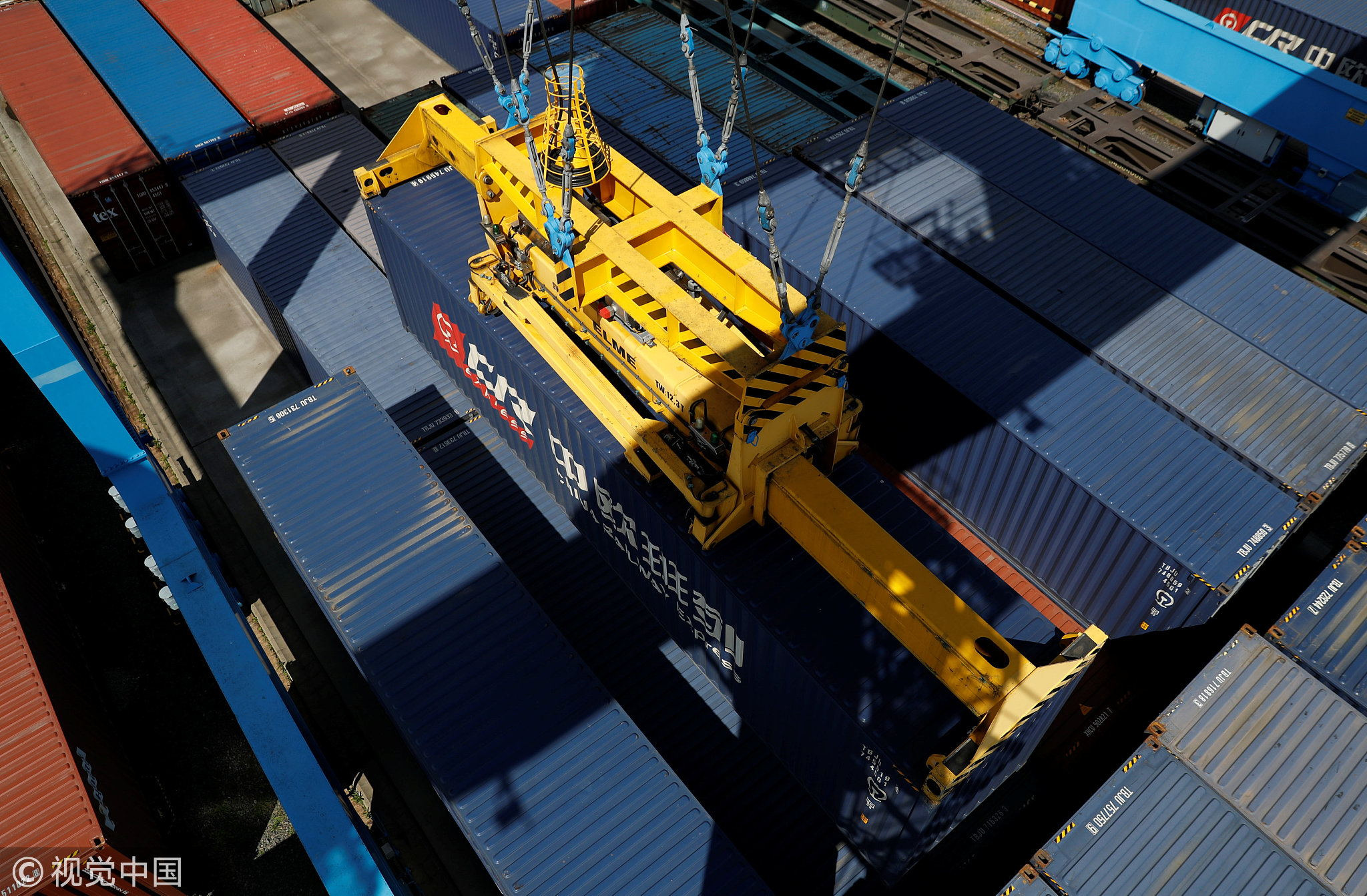
China Railway Express container is lifted by a crane at Europort terminal near Malaszewicze, Poland, May 24, 2018. /VCG Photo
China Railway Express container is lifted by a crane at Europort terminal near Malaszewicze, Poland, May 24, 2018. /VCG Photo
The southern nations of the EU are also in a state of open revolt. The Maastricht budget strictures have led to unprecedented austerity in Italy, Greece and Portugal. An agreement that was intended to pull Europe together, often with undertones of creating a counter pole to the United States, has instead led to a greater breach between the more developed countries in the north of Europe and those in the south whose economies were not at quite the same level of development. These countries also have been strongly supportive of the Belt and Road Initiative, seeing this as a way out of their dilemma.
And then we have the situation that the British public, always somewhat dubious of incorporation into a “united Europe,” voted to leave the European Union entirely. While the dust has not settled over exactly what type of relationship Great Britain will have with the EU after Brexit, it's clear that they cannot afford a total break with the close economic relations that have been built up over decades without suffering some significant setbacks.
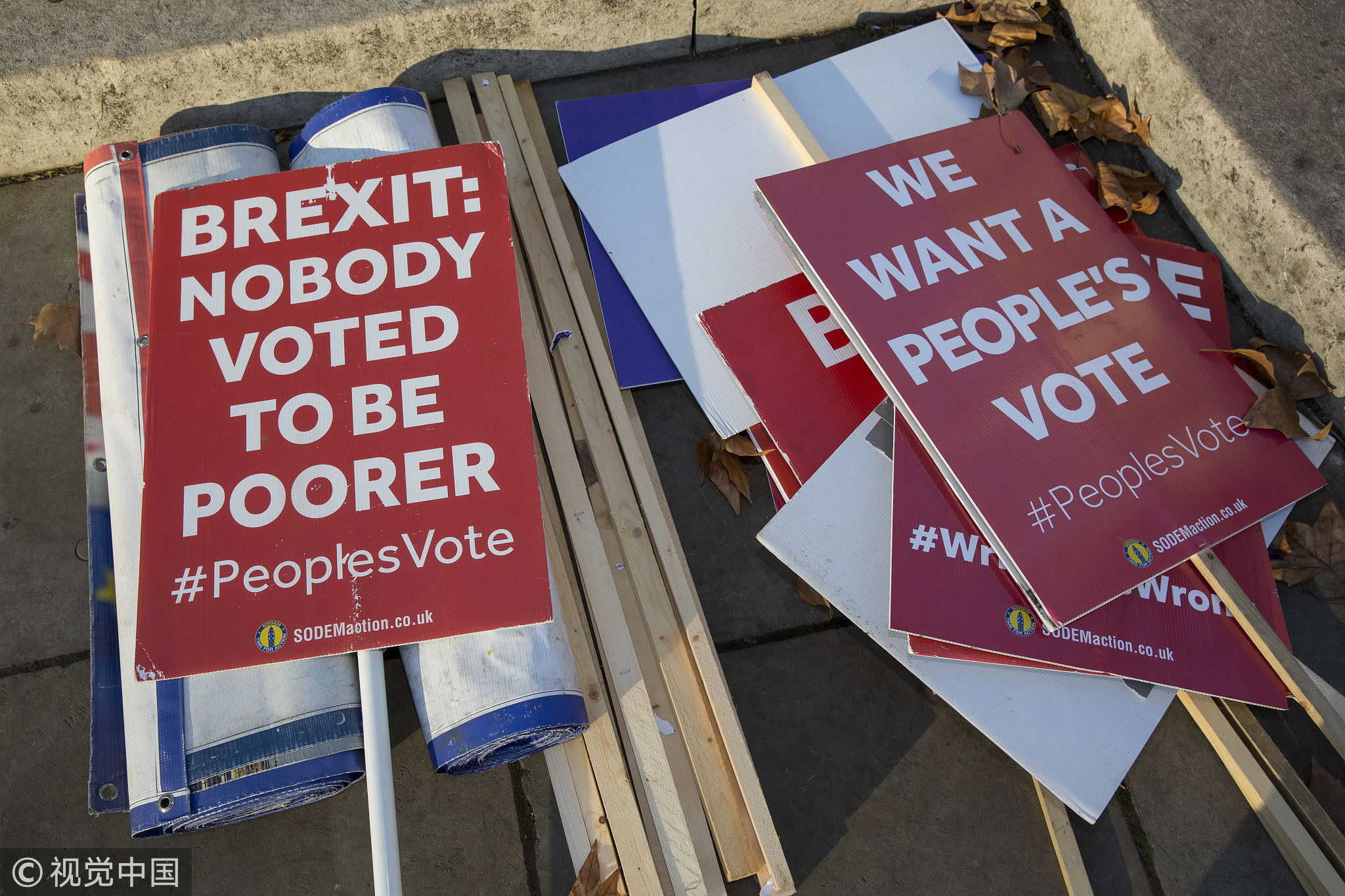
Anti-Brexit placards lay on the floor outside parliament in central London in the United Kingdom, December 13, 2018. /VCG Photo
Anti-Brexit placards lay on the floor outside parliament in central London in the United Kingdom, December 13, 2018. /VCG Photo
And now even that stalwart backer of a strong EU, France, is seriously roiled by a major social upheaval after a new round of gasoline taxes (an indirect form of austerity), were imposed, while German Chancellor Angela Merkel, Macron's counterpart in the all-important Franco-German alliance at the base of the EU, has been voted out of power.
Compete for U.S.' sweetheart, or act together?
It is clear that the U.S.-EU relationship is in a state of extreme flux. But there are some interesting developments coming out of the rather chaotic situation. Italy, for instance, is determined to buck the EU restrictions and to move for a program of infrastructure development. Italy is also in the forefront of the fight to develop China's Belt and Road Initiative as a catalyst for reviving the Italian economy. At the same time, Italian Prime Minister Giuseppe Conte has established a close relationship with the U.S. president, probably the best relationship that President Trump has with any European leader.
Conte is also intent on working with the U.S. in utilizing its own unique engineering capabilities to cooperate in aerospace development. While the EU is trying to come down heavy on the new Italian government which is bucking its authority, Italy now seems to have a good friend and supporter in the U.S. president.

U.S. President Donald Trump (R) and Italian Prime Minister Giuseppe Conte shake hands during a joint news conference at the East Room of the White House in Washington, DC, July 30, 2018. /VCG Photo
U.S. President Donald Trump (R) and Italian Prime Minister Giuseppe Conte shake hands during a joint news conference at the East Room of the White House in Washington, DC, July 30, 2018. /VCG Photo
While the EU and the U.S. may ultimately work out an agreement on trade, the Italian example also shows the possibility for individual countries to work out suitable agreements on a bilateral basis with a U.S. president who is somewhat wary of multilateral agreements. Italy is also a good example of how a country, when it prioritizes the needs of the people over the demands of the EU can survive and operate outside the strictures that the EU has imposed on its members.
And as more financial uncertainty looms, with the very real possibility of another major financial blowout even bigger than in 2008, more nations may be heading for the EU exit. Either the EU leadership begins to deal with the major dysfunction in its present structure and policy or we will again see a Europe of the Nations, with each government, again responsible to their constituents and not to some supranational bureaucracy, attempting to act in the best interests of their citizens.
(If you want to contribute and have specific expertise, please contact us at opinions@cgtn.com.)

